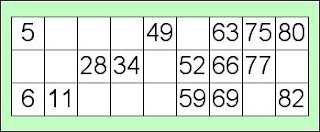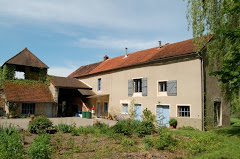However one thing has intrigued me for a long time. As a child, my mother sometimes allowed me to play with small wooden circular pieces of wood, with a number written on it. And she referred to those small discs as being part of a Kien (pronounce Keen) game.
 When we were explained the rules of Loto more than a year ago, we were told that we had to shout “Quine” (pronounce Keen) when we had a full card. Assuming there is a link between those two words is, in Dutch, a matter of applying non-scientifically founded etymology, or popular etymology. Anyway, Wikipedia could possibly help here.
When we were explained the rules of Loto more than a year ago, we were told that we had to shout “Quine” (pronounce Keen) when we had a full card. Assuming there is a link between those two words is, in Dutch, a matter of applying non-scientifically founded etymology, or popular etymology. Anyway, Wikipedia could possibly help here.The origin of the game lies in Italy, where it was played around 1530 as Lotto. The word Bingo is derived from the American version of the game, which was played in the twenties on a form called Beano. The word Beano in itself is derived from the beans which were used to cover the numbers on the card. Hence Beano was corrupted to Bingo.
The Dutch word Kien is derived from the French word Quine, which comes from the Latin word Quini (= 5), and which refers to the 5 numbers on each row of a Loto card. The forms used as well as the rules of the game seem to vary per nationality.
 The French (Loto) and the English (Bingo) use forms of 3 rows and 9 columns, whereby the first column is meant for the numbers 1 to 9, the second for 10 to 19, etc. The last row is for 80 to 90. This makes checking the numbers relatively easy. The game can be played per row (the winner is the first one who fills a row) per 2 rows (as before but with 2 rows) or per full card. When one plays by row, the French call out “Quine” (= 5); when one plays for a full card the French shout “Carton plein”.
The French (Loto) and the English (Bingo) use forms of 3 rows and 9 columns, whereby the first column is meant for the numbers 1 to 9, the second for 10 to 19, etc. The last row is for 80 to 90. This makes checking the numbers relatively easy. The game can be played per row (the winner is the first one who fills a row) per 2 rows (as before but with 2 rows) or per full card. When one plays by row, the French call out “Quine” (= 5); when one plays for a full card the French shout “Carton plein”. The Americans, as the Dutch (Bingo), play on a form of 5 x 5 squares, whereby the square in the middle does not contain a number. The 24 numbers (between 1 and 75) are either randomly put on the form, or sorted per column (1-15, 16-30, etc.). Here one can also play per row, per column, per square or per any other form determined beforehand, or of course, per full card.
And all this, because I was curious about the relation between the words Kien and Quine!
The website of La Tuilerie de Chazelle


No comments:
Post a Comment